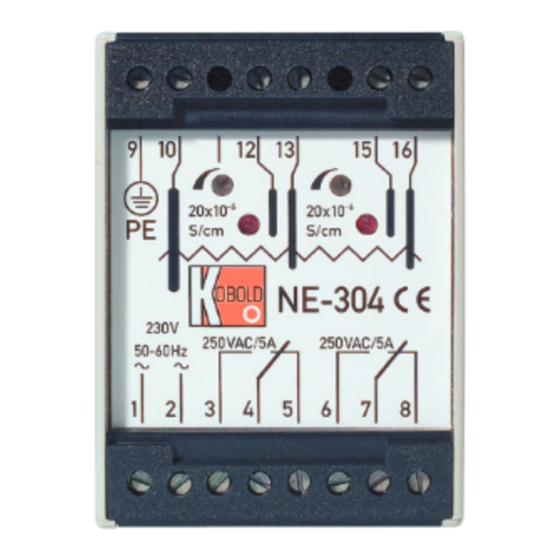
Kobold NE-104 Operating Instructions Manual
Conductive level limit switch
Hide thumbs
Also See for NE-104:
- Operating instructions manual (12 pages) ,
- Operating instructions manual (15 pages)
Table of Contents
Advertisement
Quick Links
Advertisement
Table of Contents

Summary of Contents for Kobold NE-104
- Page 1 Operating Instructions Conductive Level Limit Switch Model: NES, NE-104/-304...
-
Page 2: Table Of Contents
....................6 NE-104 Electrode Relay ..............7 NE-304 Electrode Relay ..............8 Application examples with Electrode Relay NE-104 ......10 Commissioning.................... 12 Locating and Remedying Faults ..............12 ... -
Page 3: Note
Please read these operating instructions before unpacking and putting the unit into operation. Follow the instructions precisely as described herein. The instruction manuals on our website www.kobold.com are always for currently manufactured version of our products. Due to technical changes, the instruction manuals available online may not always correspond to the product version you have purchased. -
Page 4: Regulation Use
(min./max. control). Unlike to the NE-104 with only one limit value indication, one connection for a ground electrode and one min. and max. electrode, the relay NE-304 can observe two signals. -
Page 5: Mechanical Connection
6. Mechanical Connection The electrodes can for example be screwed into the tank cover and sealed via a pipe thread. The electrode length corresponds to the desired switching points and may be shortened as necessary. The electrode tip must be free of insulating materials. -
Page 6: Electrical Connection
Numbering: shortest electrode 1; second-shortest electrode 2, etc. The Conductive Level Switch can only be used in conjunction with a suitable electrode relay (e.g. NE-104 or NE-304). Ensure that the cable gland and the housing cover of the limit switch are strongly tightened after connection. -
Page 7: Ne-104 Electrode Relay
7.2 NE-104 Electrode Relay The NE-104 electrode relay is the standard relay for all conductive limit electrodes. It is supplied with a quiescent current relay, i.e., the relay picks up (contact 6-7 closes) when auxiliary power is applied. If the electrodes are wetted or the power fails, the relay disengages (contact 7-8 closes). -
Page 8: Ne-304 Electrode Relay
7.3 NE-304 Electrode Relay The NE-304 electrode relay is a double relay with two separated electrode circuits and one reference electrode. It is supplied with a quiescent current relay, i.e., the relay picks up (contact 3-4 and 6-7 close) when auxiliary power is applied. - Page 9 Usage as one interval control and one switch point (4 electrodes) Connect the ground or reference electrode (longest rod) to terminal 10. Pump 1: Connect the Max.-switching electrode to terminal 12 and the Min.- switching electrode to terminal 13. ...
-
Page 10: Application Examples With Electrode Relay Ne-104
7.4 Application examples with Electrode Relay NE-104 Power supply Draining the tank Power supply Power supply Filling the tank Power supply page 10 NES K05/0922... - Page 11 Power supply Overflow protection Power supply Power supply Minimum level protection Power supply NES K05/0922 page 11...
-
Page 12: Commissioning
If the LED is energised Relay NE-104: Disconnect the electrode from terminals 14, 15, and 16, and short-circuit terminals 14 and 15 with a wire jumper. The relay must drop out now. If there is no reaction, the relay is faulty. -
Page 13: Maintenance
10. Maintenance The Conductive Limit Switch requires absolutely no maintenance. The electrode tips should be occasionally inspected for deposits or corrosion and should be cleaned. Insulating deposits can cause a malfunction. NES K05/0922 page 13... -
Page 14: Technical Data
IP 65 Electrode relay NE-104, NE-304 Power supply: 230, 110, 24 V ± 15 %, 50 – 60 Hz Power input: NE-104: approximately 2 VA NE-304: approximately 4 VA Floating voltage: approximately 10 VA Short-circuit-current: approximately 0.5 mA Sensitivity: adjustable 0 – 50 kΩ... -
Page 15: Order Codes
12. Order Codes Model Description Housing Electrode Electrode Screwed Number material coating fitting of electrodes A =Polyolefine complete coating 1 = 1 electrode E = Stainless T =PTFE 2 = 2 electrodes Conductive P = Polypropylene** R = Polyamide steel partial 3 = 3 electrodes NES-... -
Page 16: Dimensions
13. Dimensions 13.1 Electrodes with Housing page 16 NES K05/0922... -
Page 17: Electrode Relay
13.2 Electrode Relay NES K05/0922 page 17... -
Page 18: Disposal
14. Disposal Note! Avoid environmental damage caused by media-contaminated parts Dispose of the device and packaging in an environmentally friendly manner Comply with applicable national and international disposal regulations and environmental regulations. Batteries Batteries containing pollutants are marked with a sign consisting of a crossed-out garbage can and the chemical symbol (Cd, Hg, Li or Pb) of the heavy metal that is decisive for the classification as containing pollutants: 1. -
Page 19: Eu Declaration Of Conformance
15. EU Declaration of Conformance We, KOBOLD Messring GmbH, Hofheim-Ts, Germany, declare under our sole responsibility that the product: Conductive Limit Switch Model: NE-104, NE-304 to which this declaration relates is in conformity with the standards noted below: EN 61326-1:2013...













Need help?
Do you have a question about the NE-104 and is the answer not in the manual?
Questions and answers